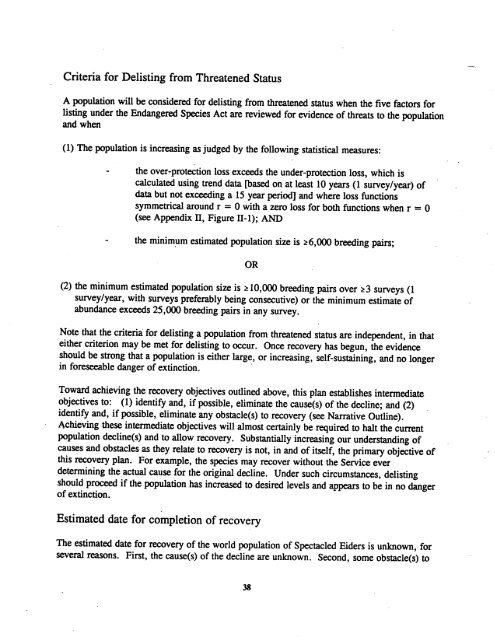A. Status of the Spectacled Eider - U.S. Fish and Wildlife Service
A. Status of the Spectacled Eider - U.S. Fish and Wildlife Service
A. Status of the Spectacled Eider - U.S. Fish and Wildlife Service
You also want an ePaper? Increase the reach of your titles
YUMPU automatically turns print PDFs into web optimized ePapers that Google loves.
Criteria for Delisting from Threatened <strong>Status</strong><br />
A population will be considered for delisting from threatened status when <strong>the</strong> five factors for<br />
listing under <strong>the</strong> Endangered Species Act are reviewed for evidence <strong>of</strong> threats to <strong>the</strong> population<br />
<strong>and</strong> when<br />
(1) The population is increasing as judged by <strong>the</strong> following statistical measures:<br />
- <strong>the</strong> over-protection loss exceeds <strong>the</strong> under-protection loss, which is<br />
calculated using trend data [basedon at least 10 years (1 survey/year) <strong>of</strong><br />
data but not exceeding a 15 year period] <strong>and</strong> where loss functions<br />
symmetrical around r = 0 with a zero loss for both functions when r 0<br />
(see Appendix II, Figure 11-1); AND<br />
- <strong>the</strong> minimum estimated population size is =6,000breeding pairs;<br />
(2) <strong>the</strong> minimum estimated population size is =10,000breeding pairs over =3surveys (1<br />
survey/year, with surveys preferably being consecutive) or <strong>the</strong> minimum estimate <strong>of</strong><br />
abundance exceeds 25,000 breeding pairs in any survey.<br />
OR<br />
Note that <strong>the</strong> criteria for delisting a population from threatened status are independent, in that<br />
ei<strong>the</strong>r criterion may be met for delisting to occur. Once recovery has begun, <strong>the</strong> evidence<br />
should be strong that a population is ei<strong>the</strong>r large, or increasing, self-sustaining, <strong>and</strong> no longer<br />
in foreseeable danger <strong>of</strong> extinction.<br />
Toward achieving <strong>the</strong> recovery objectives outlined above, this plan establishes intermediate<br />
objectives to: (1) identify <strong>and</strong>, ifpossible, eliminate <strong>the</strong> cause(s) <strong>of</strong> <strong>the</strong> decline; <strong>and</strong> (2)<br />
identify <strong>and</strong>, ifpossible, eliminate any obstacle(s) to recovery (see Narrative Outline).<br />
Achieving <strong>the</strong>se intermediate objectives will almost certainly be required to halt <strong>the</strong> current<br />
population decline(s) <strong>and</strong> to allow recovery. Substantially increasing our underst<strong>and</strong>ing <strong>of</strong><br />
causes <strong>and</strong> obstacles as <strong>the</strong>y relate to recovery is not, in <strong>and</strong> <strong>of</strong> itself, <strong>the</strong> primary objective <strong>of</strong><br />
this recovery plan. For example, <strong>the</strong> species may recover without <strong>the</strong> <strong>Service</strong> ever<br />
determining <strong>the</strong> actual cause for <strong>the</strong> original decline. Under such circumstances, delisting<br />
should proceed if <strong>the</strong> population has increased to desired levels <strong>and</strong> appears to be in no danger<br />
<strong>of</strong>extinction.<br />
Estimated date for completion <strong>of</strong> recovery<br />
The estimated date for recovery <strong>of</strong> <strong>the</strong> world population <strong>of</strong> <strong>Spectacled</strong> <strong>Eider</strong>s is unknown, for<br />
several reasons. First, <strong>the</strong> cause(s) <strong>of</strong><strong>the</strong> decline are unknown. Second, some obstacle(s) to<br />
38

















